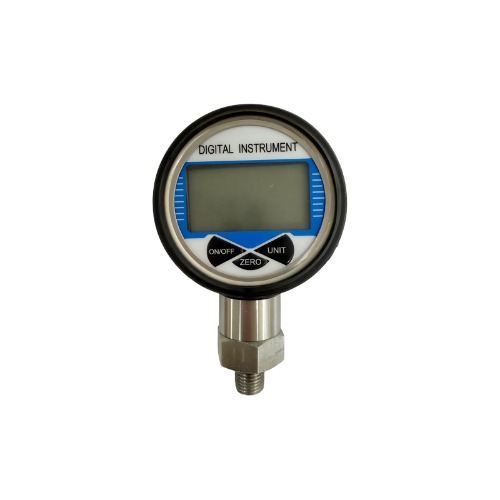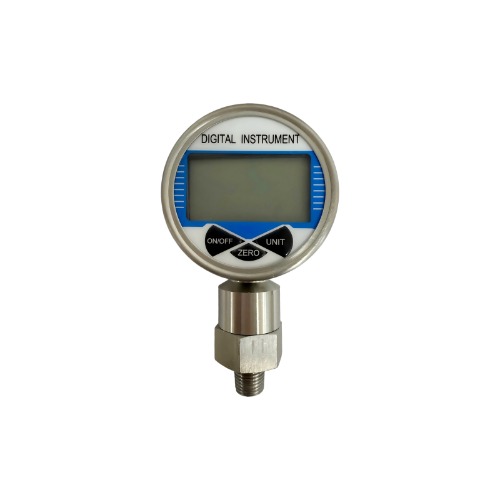Y series general stainless steel pressure gauge
Cat:Pressure Gauge
◆ Model: Y40 Y50 Y60 Y75 Y100 Y150 Y200 Y250◆ Use: This series of instruments is suitable for measur...
See Details Digital pressure gauges have significant advantages over traditional mechanical pressure gauges, especially in terms of accuracy, functional scalability, and intelligent integration.The following is a detailed analysis of its core advantages:
1,High precision and stability
·Accuracy grade
Digital display meters typically have an accuracy of ±0.1% to ±0.5% of the full scale (FS), which is much higher than that of mechanical meters, which range from ±1% to ±2.5% of the full scale.
Example:When measuring a pressure of 10 MPa, the digital display meter has an error of only ±0.01 MPa, while the mechanical meter may have an error of ±0.25 MPa.
·Long-term stability
The electronic sensor has a very small drift (<0.1% per year), while the Bourdon tube of the mechanical gauge will gradually lose accuracy due to metal fatigue.
2,Multifunctional display and operation
·Multi-parameter display:It can simultaneously display pressure, temperature, flow rate, peak/valley values, and supports one-click unit conversion (MPa/psi/bar).
· Human-Computer Interaction:Backlit LCD/OLED screen, touch buttons, multi-language interface, suitable for dim environments (such as underground operations).


3,Intelligence and integration capabilities
·Data Output:Standard features include 4-20mA, RS485, and HART protocols. Partial support for Bluetooth/Wi-Fi is also provided. It can be directly connected to PLC or SCADA systems.
·Advanced Functions
Alarm Function: Pre-set high and low pressure alarm thresholds. When triggered, the relay will output or an audible and visual alert will be given.
The data shows: The built-in storage can record up to Ten thousand sets of data (such as the Heartbeat technology of Endress+Hauser).
4,A strong ability to adapt to the environment
·Anti-vibration/Shock Resistance:No mechanical pointer, with an electronic sampling frequency of over 1kHz, suitable for applications in construction machinery, ships, etc.
·Wide temperature range operation:Industrial-grade model supports a temperature range of -40℃ to 85℃. Mechanical watches are prone to freezing at low temperatures and aging at high temperatures.
·Protection level:IP67/TP68 dust-proof and anti-aging, partially certified for explosion-proof (ATEX/IECEx).
5,Maintenance and longevity advantages
·Anti-maintenance design:There is no gear wear, and the sensor can last for over 10 years (no need for regular lubrication or calibration for mechanical watches).
·Fault Diagnosis:The self-check function can alert for sensor malfunctions, power abnormalities, etc. (such as the electronic diagnostic system of WIKA).
6,Special scenario application
·Corrosive medium:Ceramic or Hastelloy alloy sensors can withstand acids, alkalis, H2S, etc. (for chemical processing / wastewater treatment).
· Hygiene-grade requirements:316L stainless steel with spot polishing, meeting FDA/GMP standards (for food/pharmaceuticals).
7,Typical application scenarios
·Industrial Automation: Real-time monitoring of the factory pneumatic system, with data uploaded to the control room via Modbus.
·Energy industry: Record of pressure fluctuations in oil pipelines, combined with AI analysis to predict leakage risks.
·Medical equipment: Precise pressure control for ventilators, with an error of ≤ 0.1% to ensure patient safety.
Summarize:
The core advantages of digital pressure gauges lie in their high precision, digital integration and intelligent management. They are particularly suitable for fields that require remote monitoring, data traceability or harsh environments. Although the initial cost is relatively high, their long-term value is reflected in reducing human errors, lowering maintenance costs and improving system efficiency. They are one of the key sensors for the upgrade of Industry 4.0.